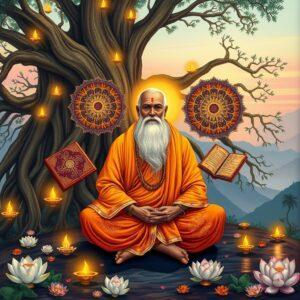
The Isha Upanishad, a principal text within Hindu philosophy, offers profound spiritual insights into the nature of reality and the self. Known also as Shri Ishopanishad, Ishavasya Upanishad, or Vajasaneyi Samhita Upanishad, it is part of the Shukla Yajurveda and remarkably concise, comprising only 18 verses. As one of the shortest Upanishads, it is revered for its depth of wisdom. The name “Isha” translates to “the Lord of the Universe,” reflecting the core teaching that the entire cosmos is pervaded by Ishwara (the Supreme Being). This Upanishad emphasizes a life of renunciation and non-attachment, recognizing the fundamental unity of the Self (Atman) and the Universe (Brahman), and is known in two recensions: Kanva and Madhyandina.
The Nature of Brahman
The Isha Upanishad centers around the concept of Brahman, the ultimate reality:
- Brahman as the Source: Brahman is the origin and foundation of everything in the universe. It is the underlying reality from which all things manifest and to which they ultimately return.
- Omnipresence: Brahman exists everywhere, both within the material world and beyond it. It is the transcendent reality that permeates all of existence.
- Transcending Dualities: Brahman is beyond all dualities, including the duality of immanence (within) and transcendence (beyond). It is both the manifest and the unmanifest, the near and the far.
- Paradoxical Nature: The Upanishad describes Brahman using paradoxes, such as “It moves and it moves not; it is far and it is near; it is within all and it is outside all.” These paradoxes point to the limitations of human language in grasping the ultimate reality.
- Liberation through Realization: Realizing Brahman through inner wisdom and direct experience leads to moksha, liberation from the cycle of birth and death. This liberation is the ultimate goal of spiritual practice.
- Unity of Atman and Brahman: The Isha Upanishad emphasizes the essential unity of the individual soul (Atman) with Brahman. This realization of oneness leads to profound freedom, bliss, and the dissolution of the illusion of separateness.
Isha Upanishad Analysis: Exploring Key Verses
Let’s delve into the meaning of some crucial verses:
- Verse 1: “Ishavasyam idam sarvam…” This opening verse declares that the entire universe is enveloped by the Lord (Isha). It advises us to live in the world while maintaining a sense of detachment from material possessions, recognizing that everything belongs to the divine.
- Verse 2: Action and Detachment: This verse discusses the importance of performing actions without attachment to their fruits. It promotes a life of selfless duty (karma) aligned with dharma, the cosmic order.
- Verses 3-4: The Eternal Soul: These verses warn against identifying solely with the physical body, which is subject to decay and death. They emphasize the eternal nature of the soul (Atman), which is beyond birth and death.
- Verses 5-8: Paradoxical Reality: These verses use poetic language to explore the paradoxical nature of Brahman, the ultimate reality. They describe Brahman as both moving and unmoving, near and far, within and without.
- Verses 9-14: The Path of Wisdom: These verses address the dangers of ignorance (avidya) and false knowledge. They urge the pursuit of true wisdom (vidya) through self-inquiry and contemplation.
- Verses 15-18: Prayers and Visions: These verses include prayers for enlightenment and a vision of the supreme reality. They express the yearning for liberation and union with the divine.
- Verse 19: Embracing Truth: This final verse calls upon us to embrace truth (satya) and live in accordance with the divine order (rta). It emphasizes the importance of aligning our actions with the cosmic harmony.
Key Terms and Concepts
A clear understanding of key terms is essential for grasping the essence of the Isha Upanishad:
- Brahman: The ultimate, unchanging reality that transcends the phenomenal world. It is the source and ground of all existence.
- Atman: The inner self or soul, identical with Brahman in essence. It is the eternal, unchanging consciousness that resides within each being.
- Maya: The illusion or veil of ignorance that obscures the true nature of reality. It is the perception of separateness and duality that prevents us from realizing our oneness with Brahman.
- Karma: The principle of cause and effect, where actions create consequences that shape our future experiences. Acting in accordance with dharma creates positive karma, while acting against it creates negative karma.
- Moksha: Liberation from the cycle of birth and death (samsara). It is achieved through the realization of the unity of Atman and Brahman.
- Dharma: Righteous conduct and duty. It refers to the ethical and moral principles that govern individual and social behavior. Living in accordance with dharma leads to harmony and spiritual growth.
- Rta: The cosmic order and harmony that governs the universe. Aligning our actions with rta brings balance and peace to our lives and the world around us.
Practical Applications for Modern Life
- Practice Detachment: Engage with the world and fulfill your responsibilities while maintaining inner detachment from material possessions and outcomes. This allows for greater peace and equanimity in the face of life’s challenges.
- Self-Reflection and Meditation: Dedicate time for self-reflection and meditation to cultivate inner stillness and connect with your true self (Atman). This practice can lead to a deeper understanding of your connection to Brahman.
For those seeking to deepen their understanding of the Isha Upanishad and incorporate its teachings into their spiritual practices, Poojn.in offers a curated selection of authentic puja items. Enhance your study and meditation with sacred tools such as Rudraksha malas, copper water vessels, and sandalwood incense sticks. Visit www.poojn.in to explore our collection and support your spiritual journey.
You can also find resources on other spiritual topics on Poojn.in. Explore articles like Planning Your Spiritual Retreat: An Ashram Stay Guide and Ramcharitmanas: A Deep Dive into Devotion and Epic Narrative.
For products that can aid in your spiritual practices, consider Small Beads Bel Mala or Tulsi Mala with Radha Locket.
Conclusion
The Isha Upanishad offers profound wisdom that remains deeply relevant in our modern world. By integrating its teachings into our daily lives, we can cultivate a harmonious balance between material success and spiritual fulfillment. The Upanishad’s emphasis on the unity of all beings encourages us to live with compassion, recognizing the divine spark within ourselves and all of creation.


